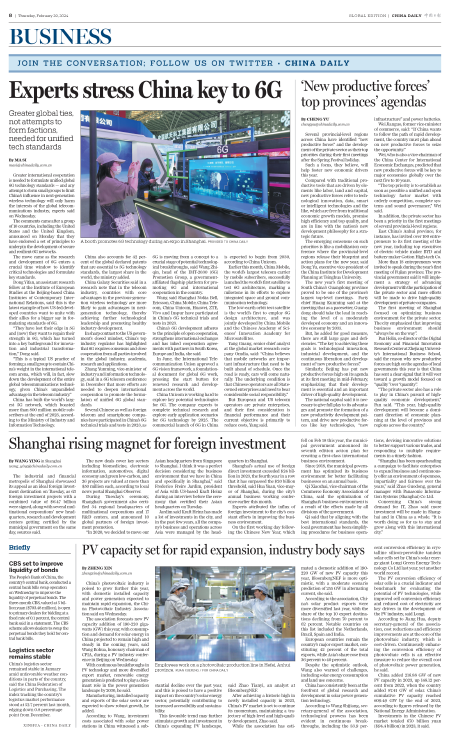Uniform technology standards require greater global connectivity rather than trying to form factions
Greater international cooperation is needed to develop a unified global 6G technology standard, and any attempt to form a small group to limit China’s influence in next-generation wireless technologies will It will only hurt the industry’s profits, experts said Wednesday.
The comments came after a group of 10 countries, including the United States and the United Kingdom, announced on Monday that they had endorsed a set of principles to underpin the development of secure and resilient 6G networks.
The move comes as 6G research and development enters a critical period of identifying key technologies and developing key standards.
Dong Yifan, an associate researcher at the Beijing-based China Academy of Contemporary International Relations Institute for Europe Studies, said this is because the U.S.-led developed world wants to unite with its allies to gain a greater say in policymaking. He said this is the latest example of the situation. 6G standard.
“They lost their edge in 5G and want to regain it in 6G, which is (now) a key battleground for innovation and industrial transformation,” Dong said.
“This is a typical US practice of forming small groups to reduce China’s weight in the international telecommunications sector, and given China’s unparalleled dominance in the telecommunications industry, it effectively controls the world’s telecommunications sector. It will slow down the development of technology as a whole.”
According to the Ministry of Industry and Information Technology, China has built the world’s largest 5G network, with more than 800 million mobile phone subscribers as of the end of 2023.
China also accounts for 42% of the world’s declared patents essential to 5G technology standards, the largest share in the world, the ministry added.
China Galaxy Securities said in a research note that in the telecommunications industry, countries with core advantages in previous-generation wireless technologies are likely to gain advantages in next-generation technologies as well, thereby achieving further technological leadership. and promote healthy industry development.
In contrast to the U.S. government’s closed-door mindset, China’s top industry regulator believes 6G will require the consensus and close cooperation of all stakeholders in global industry, academia, research, and applications. He emphasized that there is.
Zhang Yunming, vice minister of the Ministry of Industry and Information Technology, said at a 6G communications conference in December that further efforts are needed to deepen international cooperation to promote the development of a unified 6G global standard.
Wang Zhiqin, head of IMT-2030 (6G), said 6G has moved from a concept to a critical stage of potential technological breakthroughs, and several Chinese and foreign telecommunications and smartphone companies have announced plans to said it is participating in China’s 6G technology trials and tests. ) Promotion Group, which is the government’s flagship platform for promoting domestic he 6G and international cooperation.
Wang said that Shanghai Nokia Bell, Ericsson, China Mobile, China Telecom, China Unicom, Huawei, ZTE, Vivo and Inspur participated in China’s 6G technology trials and tests in 2023.
China’s 6G development adheres to the principle of open cooperation, strengthens international exchanges and signs cooperation agreements with partners in South Korea, Europe and India, he said.
In June, the International Telecommunication Union approved the 6G Vision Framework, the foundational document for global 6G work, kickstarting new research and development around the world.
China Unicom is enthusiastically working on exploring the key potential technologies of 6G. The company expects to complete technology research and explore early application scenarios for 6G technology by 2025. According to China Unicom, the commercial launch of 6G in China is scheduled to begin in 2030.
Earlier this month, China Mobile, the world’s largest telecommunications operator by mobile phone subscribers, successfully launched the world’s first satellite to test 6G architecture, marking a major milestone in its efforts to explore integrated space and ground communications technology. It became a milestone.
The low-orbit test satellite is the world’s first with 6G design architecture and was jointly developed by China Mobile and the Institute of Microsatellite Innovation of the Chinese Academy of Sciences.
Yang Guang, senior chief analyst at Omdia, a global market research company, said, “China considers mobile networks to be critical infrastructure that needs to be built ahead of schedule. The underlying condition is that all Chinese carriers are state-owned enterprises and must assume a great deal of social responsibility.”
However, carriers in Europe and the United States are private companies, and their primary consideration is financial performance, and their current goal is primarily cost reduction, Yang said.
masi@chinadaily.com.cn

A booth promoting 6G technology at an exhibition in Shanghai.Chinese daily newspaper


